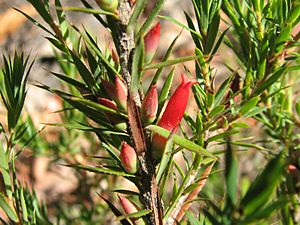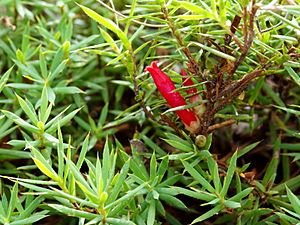Astroloma humifusum facts for kids
Quick facts for kids Astroloma humifusum |
|
|---|---|
 |
|
 |
|
| Scientific classification | |
| Genus: |
Astroloma
|
| Species: |
humifusum
|
| Synonyms | |
|
Ventenatia humifusa Cav. |
|
Astroloma humifusum, also known as the native cranberry or cranberry heath, is a small plant that grows close to the ground. It belongs to the heath family, called Ericaceae. This plant is special because it only grows in south-eastern Australia.
Contents
What Does It Look Like?
Astroloma humifusum spreads out like a mat on the ground. It can grow up to 50 cm (20 in) tall and spread out 0.5 to 1.5 meters (20 in to 5 ft) wide. Its stems are a bit hairy. The leaves look like small pine needles and are blue-green. They are about 0.5 to 1.2 cm (0.2 to 0.5 in) long.
The plant has tube-shaped flowers that are about 2 cm (0.8 in) long. These flowers are all red and usually appear from February to June. After the flowers, small green berries grow. They are round and about 0.4 to 0.6 cm (0.2 in) wide. As they get ripe, they turn reddish.
How It Got Its Name
The plant Astroloma humifusum has had a few names over time.
First Names
A Spanish botanist named Antonio José Cavanilles first described this plant in 1797. He called it Ventenatia humifusa. Later, a Scottish botanist named Robert Brown gave it its current scientific name, Astroloma humifusum, in 1810. He wrote about it in his book Prodromus Florae Novae Hollandiae.
Robert Brown also described another plant, Astroloma denticulatum. He found it in South Australia. For a while, some people thought it was just a type of A. humifusum. But now, scientists agree that Astroloma denticulatum is the same plant as Astroloma humifusum.
Sometimes, you might see the name Styphelia humifusa in old books. Some experts think this is just another name for Astroloma humifusum.
Common Names
People often call this plant the "native cranberry" or "cranberry heath." This is because early settlers in Australia ate its fruit, just like regular cranberries. Some older names for it include "juniper-leaved astroloma," "Native Cranberries," and "Ground Berry."
Where It Grows
Astroloma humifusum is found in south-eastern Australia. You can see it from Newcastle in New South Wales, all the way down into Victoria, south-eastern South Australia, and Tasmania.
It usually grows in open woodlands. It can be found in different types of soil, like sandstone and clay. It also likes wet, high-up areas called upland bogs. Other plants that often grow near it include Eucalyptus fibrosa, Eucalyptus sideroxylon, and Kunzea ambigua.
Who Eats It?
The fruit of the native cranberry is a food source for some animals. For example, the eastern bettong (Bettongia gaimardi), which is a small marsupial, enjoys eating these berries.
How People Use It
Astroloma humifusum can be a nice plant to grow in gardens, especially in rock gardens. It needs soil that drains water well.
The berries are juicy and can be eaten. However, they have a large seed inside. People can use them to make jams or other preserves. Some people describe the taste of the berries as "sweet."
An old book from 1889, called 'The Useful Native Plants of Australia', mentioned these berries. It said they have a sweet, sticky pulp around a big stone. Some people thought the pulp tasted like apples.

